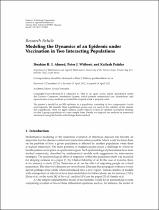| dc.contributor.author | Ahmed, Ibrahim H. I. | |
| dc.contributor.author | Witbooi, Peter J. | |
| dc.contributor.author | Patidar, Kailash | |
| dc.date.accessioned | 2023-03-08T12:29:48Z | |
| dc.date.available | 2023-03-08T12:29:48Z | |
| dc.date.issued | 2012 | |
| dc.identifier.citation | Ahmed, I. H. I. et al. (2012). Modeling the dynamics of an epidemic under vaccination in two interacting populations. Journal of Applied Mathematics, 24 , 221-224. https://doi.org/10.1155/2012/275902 | en_US |
| dc.identifier.issn | 1687-0042 | |
| dc.identifier.uri | https://doi.org/10.1155/2012/275902 | |
| dc.identifier.uri | http://hdl.handle.net/10566/8556 | |
| dc.description.abstract | Mathematical modeling of the numerical evolution of infectious diseases has become an
important tool for disease control and eradication when possible. Much work has been done
on the problem of how a given population is affected by another population when there
is mutual interaction. The mere presence of migrant people poses a challenge to whatever
health systems are in place in a particular region. Such epidemiological phenomena have been
studied extensively, described by mathematical models with suggestions for intervention
strategies. The epidemiological effect of migration within the population itself was modeled
for sleeping sickness in a paper 1 by Chalvet-Monfray et al. In the case of malaria, there
is for instance a study 2 by Tumwiine et al. on the effect of migrating people on a fixed
population. The latter two diseases are vector borne. Diseases that propagate without a vector
spread perhaps more easily when introduced into a new region. Various studies of models
with immigration of infectives have been undertaken for tuberculosis, see for instance 3 by
Zhou et al., or the work 4 of Jia et al., and for HIV, see the paper 5 of Naresh et al. | en_US |
| dc.language.iso | en | en_US |
| dc.publisher | Hindawi | en_US |
| dc.subject | Applied Mathematics | en_US |
| dc.subject | Population studies | en_US |
| dc.subject | Migration | en_US |
| dc.subject | Public health | en_US |
| dc.subject | Malaria | en_US |
| dc.title | Modeling the dynamics of an epidemic under vaccination in two interacting populations | en_US |
| dc.type | Article | en_US |

